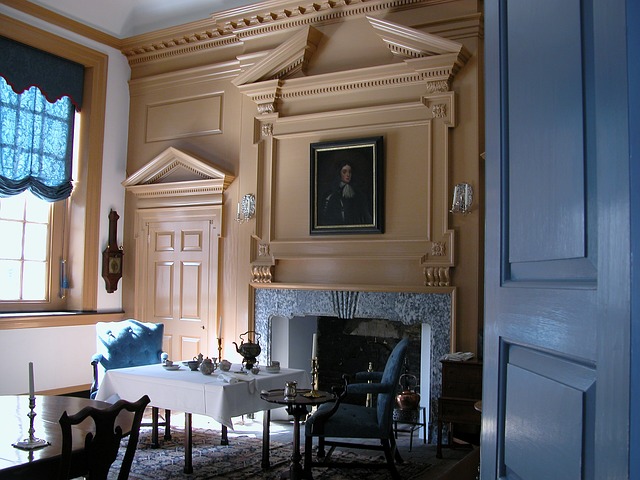By Tim Lambert
At first, life was hard and rough in the North American colonies. However, by the early 18th century people in the American colonies lived in houses as comfortable as those in Europe. Wealthy people had finely carved furniture, wallpaper, china, silver, and crystal and chairs were common. In 1742 Benjamin Franklin invented a kind of metal stove.

Of course, for the poor, things were different. Their houses were often small and crowded and their furniture was basic. They could not afford luxuries like silver but some ordinary people had pewter, which was sometimes called poor man’s silver.
On the frontier in the 18th century, life was very rough and people often lived in log cabins.
Food and Drink in Colonial America
Beer and cider were common. For the wealthy wine and brandy were imported. For ordinary people, rum became a popular drink in the late 17th century. In the 18th century, people drank both tea and coffee. However, drinking tea was seen as unpatriotic after the Boston Tea Party of 1773. People also drank chocolate. The first chocolate factory in America opened in 1765 in Massachusetts.
In the 18th century grains like rye, wheat, and barley were grown. Colonists also grew vegetables like onions, turnips, parsnips, and carrots. In the 18th century, they grew potatoes. If meat was available stew was a popular meal. People in 18th century America also ate ice cream.
Clothing in Colonial America
In the 18th century men wore breeches and stockings. They also wore waistcoats and frock coats. They wore linen shirts. Both men and women wore wigs and for men three-cornered hats were popular. Men wore buckled shoes.
Women wore stays (a bodice with strips of whalebone) and hooped petticoats under their dresses. However, in the 18th century women did not wear panties. Fashionable women carried folding fans.
Fashion was very important for the wealthy but poor people’s clothes changed very little.
Work in Colonial America
Most people in North America lived by farming. It was back-breaking work and usually lasted from dawn to dusk. However in the south by the 18th century, great plantations existed alongside the many small farms.
In North America, there were the same craftsmen found in Europe such as carpenters, coopers, tanners, millers, and blacksmiths. Apothecaries sold drugs.
By the 18th century, most towns had specialized trades such as gunsmiths, locksmiths, clock and watchmakers, silversmiths, and cabinet makers.
In the north shipbuilding flourished in the 18th century and there were many shipwrights, caulkers, rope makers, block makers, and sailmakers. By 1700 most towns also had a sawmill powered by water. In the North American colonies, lumber was abundant. So were streams and rivers. n Recreation in Colonial America
Pastimes in 18th century North America were the same as those in Europe. Horse racing was popular. So was cockfighting. Bullbaiting was also a popular ‘sport’. A bull was chained to a post and dogs were trained to attack it. Hunting and fishing were also common as a way of obtaining food as well as for fun.
Gambling was popular and people placed bets on games like cards, dice, skittles, and shuffleboard. Billiards was also a popular game.
Religion in Colonial America
In the early 18th century there was a great religious revival in the North American colonies. (Later it was given the name ‘The Great Awakening’). Leading figures in the revival were William Tennent 1673-1745, a Scottish-Presbyterian preacher, Jonathan Edwards 1703-1758, a Congregationalist, and John Davenport 1716-1757. The English preacher George Whitefield 1714-1770 also visited the colonies and won many converts.
Last revised 2025